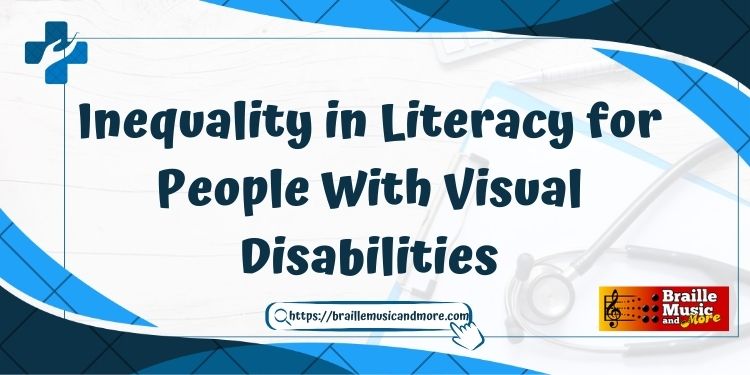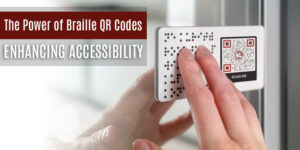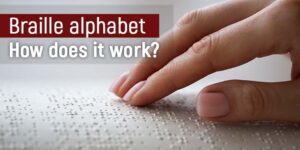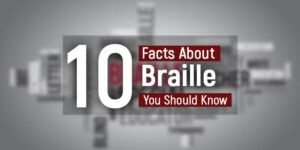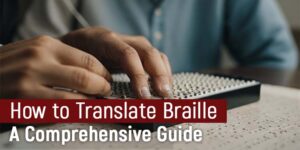Gaining literacy is crucial for achieving equality, improving one’s quality of life, and attaining independence. With independence comes the freedom to make informed decisions for oneself.
Being literate goes beyond the ability to simply write and speak words. It means actively engaging in communication and expressing oneself through meaningful participation in society’s discussions.
This blog aims to delve into the challenges that individuals with visual impairments encounter when it comes to accessing literacy. Additionally, we will underscore the significance of inclusive education.
Understanding Visual Disabilities
Visual disabilities encompass a range of conditions, including low vision or complete blindness. These conditions significantly impact an individual’s ability to read and access information. It is therefore crucial to acknowledge and address the specific needs of visually impaired individuals.
So what are the barriers to literacy for the visually impaired?
- Limited Access to resources
People with visual disabilities People with visual disabilities often face a scarcity of accessible reading materials. Standard printed books and documents are not compatible with their needs.
Braille materials, large print books, and digital resources designed for screen readers are essential, yet they remain inadequate in many regions.
- Technological Gaps
While technology has the potential to bridge gaps in literacy, it can also be a source of inequality. Accessible technology, such as screen readers and text-to-speech software, is not always readily available or affordable for individuals with visual impairments.
- Lack of Inclusive Education
Inclusive education is a cornerstone of addressing literacy inequality. However, many educational institutions are not equipped to support students with visual disabilities. Classroom adaptations, specialized instruction, and accessible learning materials are often overlooked.
Sometimes putting ourselves into the shoes of otters can also help us understand things better. Imagine your child is given audiobooks with headphones with the same material as everything that should be in the books.
What would you think of this method?
Maybe you won’t approve of this. However, this aint happening as students because the state defines reading and not listening, literacy.
Yet a lot of students don’t have access to literacy.
The Importance of Inclusive Education
Inclusive education promotes equal opportunities for all visually impaired students, regardless of their abilities or disabilities. The definition of literacy is the same for people with visually impaired as normal people. Visually impaired with braille tactile code can be literate and that helps them to be involved in society.
- Accessible Learning Materials
Efforts must be adequately made to bridge the gap and distribute the materials in various formats like braille, large print, and digital formats compatible with screen readers. This will ensure that individuals with visual impairments have equal access to information.
- Specialized Training for Educators
Educators play a pivotal role in creating inclusive learning environments. Training programs should be implemented to equip teachers with the knowledge and skills needed to support students with visual disabilities effectively.
- Technological Advancements
Investments in accessible technology are crucial. This includes developing and improving screen reader software, creating user-friendly interfaces, and ensuring that websites and digital platforms are designed with accessibility in mind.
- A Collective Responsibility
Promoting literacy for people with visual disabilities is not the sole responsibility of individuals with disabilities themselves. It is a collective effort that involves governments, educational institutions, publishers, technology developers, and society at large.
But braille isn’t the only pathway for the visually impaired to get education or jobs or get literacy. Not all people with disabilities read Braille.
So what can you do to help the visually impaired other than braille?
- Larger Print for Independence
People with visual disabilities rely on larger prints to understand the subject matter. Some people do not even require braille as they can see well enough tp read properly through the large formatted prints.
- Audio Content
Audio content assists the visually impaired in processing and understanding by just listening to it. If a person is visiting a doctor, or a lawyer, helping them with an audio format promotes independence and prevents inequality in education, literacy and information.
- Digital Compliance
The world has gone digital, and digital compliance is a must for businesses to include visually impaired individuals in activities and give them access to documents.
Final Thoughts
Ensuring literacy for individuals with visual disabilities goes beyond being a basic right; it serves as a pathway to independence and meaningful participation in society.
It is crucial to address barriers such as limited resources, technological gaps, and the need for inclusive education. Providing accessible materials, specialized training for educators, and embracing technological advancements are pivotal in overcoming these challenges.
Promoting equal opportunities for individuals, regardless of their visual abilities, requires a collective effort from various stakeholders to bridge the gap. Explore Braille Music & More for comprehensive Braille transcription services.

